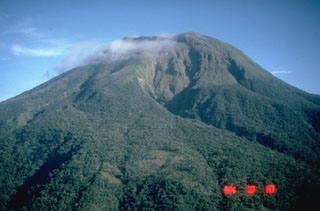Report on Bulusan (Philippines) — 6 November-12 November 2024
Smithsonian Institution / US Geological Survey
Weekly Volcanic Activity Report, 6 November-12 November 2024
Managing Editor: Sally Sennert.
Please cite this report as:
Global Volcanism Program, 2024. Report on Bulusan (Philippines) (Sennert, S, ed.). Weekly Volcanic Activity Report, 6 November-12 November 2024. Smithsonian Institution and US Geological Survey.
Bulusan
Philippines
12.769°N, 124.056°E; summit elev. 1535 m
All times are local (unless otherwise noted)
PHIVOLCS lowered the Alert Level for Bulusan to 0 (the lowest level on a scale of 0-5) at 0800 on 12 November based on monitoring data. Based on data from the seismic network the number of volcanic earthquakes had declined to background levels (0-5 earthquakes per day) in late August, and since then earthquakes have been characterized as weak volcano-tectonic events at depths less than 10 km. The seismic patterns indicated that they may have been influenced by tectonic stresses related to a M 6.6 earthquake on 18 August 2020 along the nearby Masbate segment of the Philippine Fault Zone (PFZ). Data from continuous GPS and electronic tilt measurements showed variable inflation beneath the S and NE flanks during December 2022-September 2023; shallow hydrothermal processes may have contributed to the deformation, though movement was likely related to the PFZ. Sulfur dioxide gas emissions from summit vents were low, averaging 76 tonnes per day since October 2023. The public were reminded not to enter the 4-km-radius Permanent Danger Zone (PDZ) and to be vigilant around the vents on the SSE flank.
Geological Summary. Luzon's southernmost volcano, Bulusan, was constructed along the rim of the 11-km-diameter dacitic-to-rhyolitic Irosin caldera, which was formed about 36,000 years ago. It lies at the SE end of the Bicol volcanic arc occupying the peninsula of the same name that forms the elongated SE tip of Luzon. A broad, flat moat is located below the topographically prominent SW rim of Irosin caldera; the NE rim is buried by the andesitic complex. Bulusan is flanked by several other large intracaldera lava domes and cones, including the prominent Mount Jormajan lava dome on the SW flank and Sharp Peak to the NE. The summit is unvegetated and contains a 300-m-wide, 50-m-deep crater. Three small craters are located on the SE flank. Many moderate explosive eruptions have been recorded since the mid-19th century.
Source: Philippine Institute of Volcanology and Seismology (PHIVOLCS)

